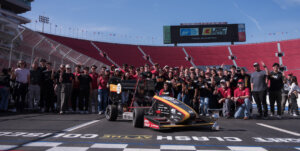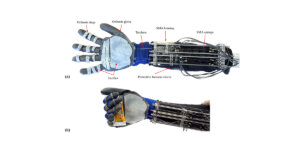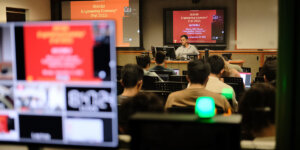
Traveler I, the SC Solar Car team’s first vehicle, is currently still under construction but is expected to be complete in time to compete in the American Solar Challenge this summer. (Illustration/ Chris Kim)
Building a fully operational electric car, powered only by the sun, from scratch, is no small undertaking.
Now, imagine racing it over a thousand miles on the Oregon Trail this summer — beginning in Independence, Missouri and ending in Idaho.
That’s the challenge that Jack Carroll, B.S. EE ’21, and the rest of the SC Solar Car Team have signed up for.
“I’m really passionate about using engineering to develop sustainable solutions to environmental problems,” said Carroll, who serves as the team’s project manager and who is currently pursuing a master’s degree in green technologies from the USC Viterbi School of Engineering. “SC Solar Car is an amazing team of individuals who share this passion, and I believe we’re really paving the way for a future of clean energy and more sustainable transportation technologies.”
A diverse team of 15 to 20 undergraduate and graduate students, SC Solar Car is dedicated to designing and building USC’s first-ever solar-powered race vehicle. The ultimate goal of SC Solar Car is to compete in the American Solar Challenge (ASC), a long-distance car race across the United States for solar-powered vehicles designed and built by teams from universities around the world. The ASC gives engineers an opportunity to push the limits of clean energy technologies with innovations aimed to mitigate the devastating impacts of fossil fuels on the earth’s climate for future generations. The SC Solar Car unit, Carroll said, is on track to compete in this year’s race, which will occur in July of 2022.
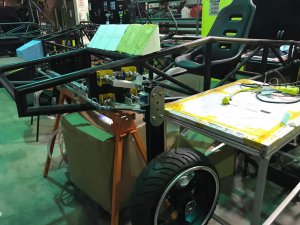
Construction on Traveler I is still ongoing. Image shows the suspension being assembled onto the car’s chassis. (Image Courtesy of Carroll)
Since its launch in 2014, SC Solar Car has worked tirelessly to research, brainstorm, design, problem-solve, and finally, begin building their first vehicle, Traveler I — which began in spring of 2018.
“We’re still in the building stage at the moment, but we’re close to completion. Traveler is really a culmination of years of effort, so getting to watch everything really come together in these final stages has been really exciting,” Carroll said.
Traveler I, which is expected to reach a top speed of around 40 mph, will be powered by an array of solar cells on the car’s roof. Its roof was designed to be as large and flat as possible to maximize surface area and accommodate as many solar cells as possible. The vehicle will be about 15-feet-long and 6-feet-wide, with a central driver cabin surrounded by the solar array built on a carbon fiber top shell. The team has not yet decided who will drive the car during the race. Traveler’s solar array is fully hand-built by students, which sets it apart from many of the other design teams that participate in the ASC.
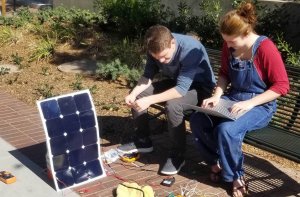
SC Solar Car members running tests on panels for the solar array, which was fully hand-built by students. (Image Courtesy of Jack Carroll)
“A lot of top teams with tons of funding and sponsors will pay a company to manufacture the solar array for the car,” Carroll said. “That makes a more reliable, higher-performing product, but we take pride in the process we’ve developed to assemble and encapsulate every panel that goes on our car.”
SC Solar Car is predominately funded by the Viterbi Design Team Fund. The team has also received support from crowdfunding, sponsorships, and donations. The team works out of the USC Baum Family Maker Space.
Carroll served as the team’s electrical lead from 2018 until he was appointed project manager this past spring. As project manager, Carroll is responsible for overseeing operation of the team as a whole and keeping everything moving forward smoothly and efficiently. He coordinates regular meetings with the team and the executive board and maintains communication with Ashkan Davani, the team’s faculty advisor, the USC Viterbi School, and ASC.
“When I first joined the SC Solar Car team, I was struck at how welcoming Jack was, and how skilled he was at explaining the physical concepts that went into designing the solar car,” said Julius Ball-Heldman, a senior studying chemical engineering with a focus in sustainable energy and one of the new electrical leads for SC Solar Car. “Jack knows the technical side of the car like the back of his hand, and I’m confident that under his leadership, the team’s efforts will be a success.”
SC Solar Car’s emphasis on clean energy was part of what drew Carroll to join the team his freshman year. According to Carroll, he developed an interest in sustainability and the environment when he was young.
“Growing up, I spent a lot of time camping and hiking with my family. I was also in cub scouts and boy scouts,” Carroll said. “I’ve always really loved being outside and being in nature, so respecting and protecting the earth have always been important to me. I don’t know exactly what I want to do in the future, but I do know I want to keep channeling this passion by working to make technologies that are cleaner and more sustainable and that have a real, positive impact on the world.”
Published on November 30th, 2021
Last updated on November 30th, 2021




